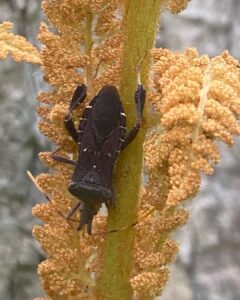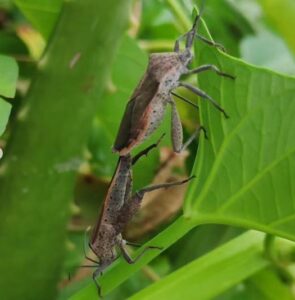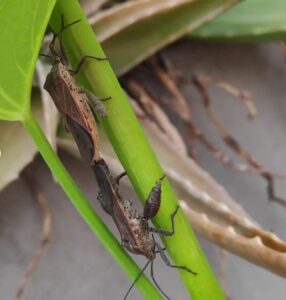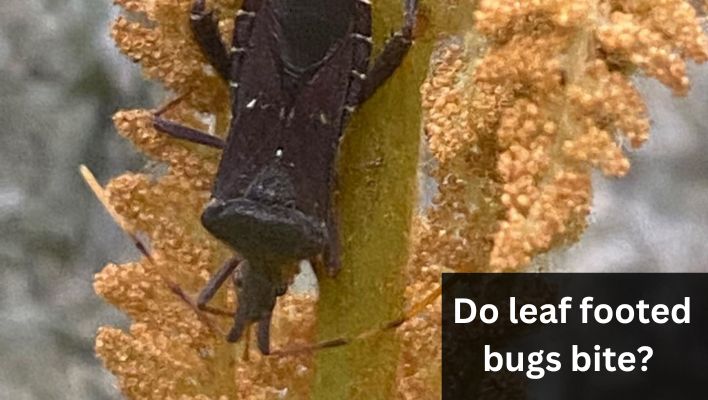Have you ever stumbled upon those peculiar bugs with elongated bodies and leaf-like hind legs? You know, the ones that seem straight out of a sci-fi movie? Well, they’re called leaf-footed bugs, and they’ve got everyone buzzing with questions. But here’s the biggie: Do leaf-footed bugs bite?
Leaf-footed bugs are fascinating creatures that capture our attention with their unique appearance and intriguing behavior. With their elongated bodies and leaf-shaped hind legs, these bugs have earned their distinctive name.
But what piques our curiosity is whether leaf-footed bugs bite or pose any threat to humans. In this blog, we’re diving deep into the world of leaf-footed bugs to unravel the truth about their biting behavior.
We’ll explore their fascinating characteristics, their knack for camouflage, and of course, whether or not they’ve got a mean set of chompers.
So, if you’ve ever wondered if leaf-footed bugs are harmless leaf-lovers or stealthy biters, stick around. We’re about to uncover the biting truth about these extraordinary insects. Get ready to be bug-struck.
What are Leaf-Footed Bugs?
Leaf-footed bugs, also known as Coreidae, belong to a diverse family of insects that will surely catch your eye with their unique features. These fascinating bugs can be found in various parts of the world, including North and South America, Europe, and Asia. So, what sets these critters apart?
First, let’s talk about their appearance. Leaf-footed bugs are medium to large-sized insects, typically ranging from 0.5 to 1 inch (1.3 to 2.5 cm) in length. One of their most distinctive features is their hind legs, which appear flattened and expanded, resembling leaf-like structures. Hence, their intriguing name.

In terms of coloration, leaf-footed bugs exhibit remarkable diversity. Some species showcase vibrant hues of green, brown, or even reddish tones, while others may possess intricate patterns or markings on their bodies. Their bodies are elongated and slender, with a triangular shape when viewed from above.
When it comes to habitat, leaf-footed bugs are incredibly adaptable creatures. You can find them in a wide range of environments, including forests, meadows, gardens, and even agricultural fields. They have a knack for hiding in vegetation, blending in effortlessly with leaves and stems thanks to their remarkable camouflage.
Leaf-footed bugs are primarily herbivores, which means they have a plant-based diet. They typically feed on the sap of various plants, piercing the plant tissues with their needle-like mouthparts to extract nutritious juices. While they primarily target fruits, seeds, and nuts, they may also feast on the leaves, stems, or flowers of their host plants.
It’s important to note that not all species of leaf-footed bugs have the same feeding preferences. Some are specialized and have specific host plants they rely on for survival, while others are more generalists and can adapt to a broader range of plant species.
Do Leaf-Footed Bugs Bite?
Now, let’s get to the heart of the matter: Do leaf-footed bugs bite? The short answer is No, leaf-footed bugs are not capable of biting.
Leaf-footed bugs have piercing mouthparts, which they use to extract plant sap. Their mouthparts are designed for piercing through plant tissues, not for biting or harming humans or pets. Their primary focus is satisfying their herbivorous appetites rather than seeking out a blood feast. So leaf-footed bugs do not bite.
The likelihood of a leaf-footed bug biting you or your furry friends is relatively low, considering their preference for plants and their tendency to avoid confrontation. In most cases, they’ll simply try to flee when confronted by a potential threat.
So, unless you unintentionally find yourself in a leaf-footed bug’s line of defense, you can breathe a sigh of relief knowing that their bites are rare and usually harmless.
Are Leaf-Footed Bug Bites Harmful
When it comes to the potential harm caused by leaf-footed bug bites, you’ll be relieved to know that their bites are generally harmless and rarely result in serious complications for humans and pets. Leaf-footed bugs are not known to transmit diseases to humans or pests. Here is what attracts leaf-footed bugs to your garden and home.
If you happen to be on the receiving end of a leaf-footed bug’s defensive bite, you may experience minor discomfort or irritation at the site of the bite.

The sensation can vary from person to person, with some describing it as a mild pinprick or a slight sting. However, it’s important to emphasize that these reactions are typically minimal and temporary.
In rare cases, individuals with sensitive skin or allergies may experience a stronger reaction to a leaf-footed bug bite. This can manifest as localized redness, swelling, itching, or a mild allergic response. If you notice any unusual or severe symptoms after a leaf-footed bug bite, it’s advisable to consult a healthcare professional for proper evaluation and guidance.
While leaf-footed bug bites are generally harmless, it’s important to note that everyone’s sensitivity and reaction can vary. If you or your pet has a history of severe allergic reactions to insect bites or stings, it’s always wise to take extra precautions and seek prompt medical attention if needed.
Identifying Leaf-Footed Bug Bites
Recognizing leaf-footed bug bites on the skin can help understand the source of any discomfort or irritation you may be experiencing. Although leaf-footed bug bites are relatively uncommon, it’s still useful to know how to identify them. Here are some tips to help you recognize leaf-footed bug bites:
- Appearance: Leaf-footed bug bites typically appear as small, red bumps on the skin. They may resemble other insect bites, such as kissing bugs, mosquitoes, or flea bites. The bites are usually singular or found in small clusters, depending on the severity of the encounter.
- Mild Irritation: Leaf-footed bug bites often cause mild irritation or itchiness at the site of the bite. The level of discomfort can vary from person to person, but it’s generally not as intense as other insect bites.
- Localized Redness: A leaf-footed bug bite may be accompanied by localized redness around the affected area. The redness is typically limited to the immediate vicinity of the bite.
It’s important to note that leaf-footed bug bites can be easily mistaken for bites from other insects. Without witnessing the actual bite or having knowledge of leaf-footed bug presence, it can be challenging to definitively attribute a bite to a leaf-footed bug.
Therefore, if you suspect a leaf-footed bug bite, it’s helpful to consider factors such as the presence of these bugs in your surroundings.
If you’re uncertain about the source of a bite or experience any unusual or severe symptoms, it’s advisable to consult a medical professional. They can provide an accurate diagnosis and recommend appropriate treatment if necessary.
What to Do If Bitten by a Leaf-Footed Bug
If you find yourself on the receiving end of a leaf-footed bug bite, there are several steps you can take to minimize any discomfort and promote healing. Here’s what you should do if you’re bitten:
- Clean the Area: Start by gently cleaning the affected area with mild soap and water. This helps remove any potential irritants or bacteria that may have been introduced by the bug’s mouthparts.
- Apply Cold Compress: If you experience any swelling or itching, applying a cold compress or an ice pack wrapped in a cloth can provide relief. The cold temperature helps reduce inflammation and soothes the skin.
- Avoid Scratching: Although it may be tempting, avoid scratching the bite area. Scratching can potentially break the skin, leading to a higher risk of infection or more severe skin irritation.
- Over-the-Counter Remedies: Over-the-counter anti-itch creams or ointments containing ingredients like hydrocortisone or calamine can be applied topically to alleviate itching and reduce redness. Follow the instructions on the packaging for proper usage.
- Oral Antihistamines: If the itching is particularly bothersome, taking an oral antihistamine, as directed by a healthcare professional, can help relieve symptoms of allergic reactions and reduce itching.
- Monitor for Allergic Reactions: While severe allergic reactions to leaf-footed bug bites are rare, it’s essential to be vigilant. If you experience symptoms such as difficulty breathing, severe swelling, dizziness, or any other signs of a severe allergic reaction, seek immediate medical attention.
- Consult a Healthcare Professional: If the bite area becomes increasingly painful, shows signs of infection (such as pus, warmth, or increasing redness), or if you have any concerns about the bite, it’s advisable to consult a healthcare professional. They can provide a proper evaluation and recommend appropriate treatment.
Remember, most leaf-footed bug bites are minor and self-limiting, requiring only basic care. However, if you experience any unexpected or severe symptoms, it’s always better to err on the side of caution and seek medical advice.

How to Prevent Leaf-Footed Bug Bites
Preventing leaf-footed bug bites is the best approach to avoid any potential discomfort or irritation. Here are some practical tips to help you minimize encounters with leaf-footed bugs:
- Seal Entry Points: Inspect your home for cracks, gaps, or openings that may serve as entry points for leaf-footed bugs. Seal these openings using caulk or weatherstripping to prevent their entry into your living spaces.
- Screen Windows and Doors: Install screens on windows and doors to create a barrier between the bugs and the indoors. This allows fresh air to flow while keeping the leaf-footed bugs outside.
- Remove Hiding Places: Leaf-footed bugs tend to seek shelter in outdoor areas, such as piles of debris, woodpiles, or dense vegetation. Regularly clean and maintain your yard, removing potential hiding spots to discourage their presence.
- Maintain a Well-Groomed Garden: A well-groomed garden can help reduce leaf-footed bug populations. Remove any fallen fruits, nuts, or seeds that can attract these bugs. Prune plants and shrubs to improve airflow and minimize hiding places.
- Consider Natural Repellents: Some natural repellents, such as neem oil or essential oils like peppermint, DE, or citronella, may help deter leaf-footed bugs. Apply these repellents to plants or use them in localized areas where you want to discourage bug activity.
- Practice Vigilance: When spending time outdoors, especially in areas known to have leaf-footed bugs, stay vigilant. Be aware of your surroundings and avoid handling or squishing these insects, as they may bite in self-defense.
- Seek Professional Pest Control: If you’re dealing with a significant leaf-footed bug infestation that poses a persistent problem, consider consulting a professional pest control service. They can provide targeted treatments to address the issue effectively.
By implementing these preventive measures, you can greatly reduce the likelihood of encountering leaf-footed bugs and, consequently, the risk of being bitten.
Do leaf-footed bugs bite FAQs?
Can leaf-footed bug bites cause serious health problems?
Leaf-footed bug bites generally do not cause serious health problems. Their bites are typically harmless and rarely result in significant complications for humans.
The majority of people may only experience minor discomfort, such as a slight pinch or itching sensation. In rare cases, some individuals may develop mild allergic reactions, characterized by redness, swelling, or itching at the bite site. However, severe health problems as a direct result of leaf-footed bug bites are extremely uncommon.
Are leaf-footed bugs aggressive?
Leaf-footed bugs are not considered aggressive insects. They do not seek out human or pet contact, nor do they exhibit aggressive behavior.
Leaf-footed bugs are primarily herbivorous and use their piercing mouthparts to feed on plant sap. However, if they feel threatened or cornered, they may resort to defensive measures, which can include biting.
It’s important to note that their bites are defensive rather than aggressive or predatory. Leaf-footed bugs are more likely to flee or release a pungent odor as a defense mechanism rather than engaging in aggressive behavior.
Can leaf-footed bugs transmit diseases to humans?
Leaf-footed bugs are not known to transmit diseases to humans. Unlike some other insects, such as mosquitoes or ticks, leaf-footed bugs are not considered disease vectors.
They do not feed on human blood as a primary food source and are not associated with the transmission of any major illnesses. Leaf-footed bugs primarily feed on plant sap, using their specialized mouthparts for piercing plant tissues.
Therefore, you can rest assured that encountering a leaf-footed bug is unlikely to result in the transmission of diseases to humans.
How long does a leaf-footed bug bite take to heal?
The healing time for a leaf-footed bug bite can vary depending on individual factors and the specific reaction to the bite. In general, leaf-footed bug bites are minor and tend to heal relatively quickly.
For most people, the discomfort and visible signs of the bite, such as redness or itching, usually subside within a few days to a week.
However, individual healing times can vary. Factors such as the individual’s immune response, skin sensitivity, and any underlying allergies can influence the healing process.
If you notice any signs of infection or if the bite does not show signs of improvement within a reasonable time frame, it is advisable to consult a healthcare professional for further evaluation and guidance.
Should I be concerned if I find leaf-footed bugs in my garden?
The presence of leaf-footed bugs in your garden does not necessarily warrant immediate concern. Leaf-footed bugs are part of the natural ecosystem and are commonly found in outdoor environments. While they primarily feed on plant sap, they can occasionally cause damage to fruits, nuts, or ornamental plants.
However, their impact on overall garden health is usually minimal unless there is a large population or specific plants are being heavily targeted.
In most cases, maintaining a well-groomed garden, removing fallen fruits and debris, and implementing good gardening practices can help minimize leaf-footed bug populations.
If you notice significant damage or persistent infestation that affects the health of your plants, you may consider employing integrated pest management strategies or seeking advice from a local agricultural extension service or professional pest control service to address the issue effectively.
Conclusion
Leaf-footed bugs are fascinating insects with distinctive characteristics. They have piercing mouthparts but primarily use them to feed on plant sap rather than bite humans or pets.
In rear cases when they bite their bites are generally harmless and rarely cause serious health problems. While minor discomfort or mild allergic reactions may occur in some cases, severe complications are extremely uncommon. Also, It’s important to note that leaf-footed bugs do not transmit diseases to humans.
Prevention is key when it comes to leaf-footed bugs. Sealing cracks and openings in homes, removing potential hiding places, and using screens on windows are effective measures to minimize encounters.
Maintaining a well-groomed garden also reduces leaf-footed bug populations. However, if you find yourself dealing with a persistent infestation or have concerns about bites, consulting a professional pest control service or seeking medical advice is recommended.
